An Enterprise Social Analytics Dashboard to Support Competence Valorization and Diversity Management
Abstract
1. Introduction
- We define a computational model to identify network leaders and topic leaders, which draws on leadership models in organization science and on multiplex networks. The model parameters can be tuned to balance in different ways needs and priorities identified by enterprise managers.
- We design an magentaESAD that incorporates the model of network leadership and supports the extensive analysis of social behaviors in networked enterprises, to detect differences, commonalities and anomalies in the behaviors of co-workers as a function of gender, role, time, and areas of expertise [11]. The system can be used by managers for career promotion, team building, and diversity management, as well as by company’s social analysts to monitor social behaviors and information flow in the workplace.
- We consider the case study of a large networked enterprise, Reply (http://www.reply.com/en/, accessed on 1 September 2021), which provided us with a three-year dataset of multilingual users’ communications within their proprietary social network, TamTamy. Our use case (to the best of our knowledge, the largest and lengthiest enterprise dataset used in literature) demonstrates that this type of “internal” social analytics may deliver more timely and actionable insights for human capital management, diversity management, and early detection of potential problems.
2. Related Studies
- Bonding ties are the edges in a social network connecting an individual with other actors in the network.
- Bridging ties are those connecting otherwise isolated groups or communities within the network.
3. System Objectives and Overview
- Time/Topic selection: in this step, a subset of threads can be generated by defining a time interval and optionally a topic of interest. This enables to perform both a detailed leadership analysis on a time interval and to identify network leaders on specific topics of interest.
- Parameters selection and Multiplex network generation: where managers can control the computation of our Model of Network Leadership—see Section 5 for the details about the model, the weighted multiplex network, and the parameters.
- Leadership analysis and visualization: in this final step, managers are supported in the analysis of the resulting network leaders and optionally, in order to refine their investigation, to iteratively back on previous steps by changing the subset of threads or the model’s parameters. General properties of the network (or sub-network) can be also investigated, such as connectivity, flow of information, and members’ activity, depending on gender, role, and discussion topic.
4. Use Case Description: The TamTamy Enterprise Social Network
| thread_id, thread_title, thread_author, timestamp, thread_tags, author_title, author_gender(0=male,1=female), thread_content, {comment_id, commenter, commenter_title, gender, timestamp, comment_content,} |
5. A Computational Model of Network Leadership
5.1. Centrality Measures
5.2. A Multiplex Model of Leadership Centrality
5.3. Measuring Brokerage of Network Leaders
5.4. Topic Leaders
| investimenti_ online | digital_ marketing |
| perspective_ engage | analisi_ delle_ performance |
| TOPIC#:169 | TOPIC#:162 |
| user_ experience | mobile_ pos |
| news_ pay | pay_ reply |
| carte_ di_ credito | user_ experience |
| credit_ card | soluzione_ di_ mobile_ pos |
| metodo_ di_ pagamento | sistemi_ di_ pagamento |
| american_ express | circuiti_ di_ pagamento |
| pagamenti_ online | gestione_ coupon |
- technical (T), e.g., mobile applications, big data, responsive design;
- organization/administrative (O/A), e.g., project management, potential customers, team building;
- leisure (L), e.g., xmas party, blood donation, birthday party.
5.5. Summary of the Parameters
6. The Enterprise Social Analytics Dashboard
7. Use-Case Analysis
- Mangers: Managers can use the platform to support career advancements, by inspecting the network leadership of selected candidates, or by identifying possible candidates not previously considered (as in Figure 4); they can use the platform to form a project team, by generating topic networks (as in Figure 5); they can analyze anomalies in user’s and group social behaviors and decide whether to take appropriate actions.
- Social Analysts: Large companies today often include or engage specialized teams for social analytics: this is the case, for example, in Reply. Social analysts can be supported by our platform in deriving general statistics on the behavior of coworkers. Useful questions that can be answered through our platform are: What have been the main topics of discussion in a given timespan (as in Figure 6)? Are there significant differences in the social behavior of coworkers, according to time, role, and gender? Does the social network encourage the sharing of knowledge (e.g., does the dimension of topic networks—on selected topics considered central—increases or decreases? Is there a tendency to create closed circles?), etc. Examples of the latter two types of analytics are provided in the section.
7.1. Diversity Management: Are There Gender Differences in Networking Behaviors?
- Females are more authors than commenters: While the number of active females stays more or less the same during the three years (20–23%), women progressively became more proactive (female thread authors increase from 15% to 25%); furthermore, executive (managers or partners) women became significantly (statistical significance () against the null hypothesis was assessed using the z-score test https://en.wikipedia.org/wiki/Z-test, accessed on 1 September 2021) more active. In our case, the null hypothesis is when the measured statistics of a conditional event is marginally different from the prior probability of the unconditioned event. For example, here, we compare the observed percentage of active female executives with the prior probability of female executives.) more active than their male counterpart, since active female executives have been 41% of active executives in 2014, even though female executives were 27%. These data show that, as the use of TamTamy as a collaboration tool was progressively encouraged by the company, women increased their empowerment ability. Instead, the percentage of female commenters shows some variability, with a peak in 2013.
- Females excel as network brokers: Table 2 shows that women are systematically among the top brokers. The percentage of women in top brokers is significantly (see previous footnote) higher than the percentage of active female users. Women excel in the ability to share information, and their intermediary role is highlighted in the ESN.
- Females are no different from males as central leaders: The table also shows that women are among top central leaders proportionally to their presence (though we noted that the majority of these top leaders are placed in the highest positions of the ranking), but this percentage drops to 7% in 2014. However, as also shown in the last column of Table 2, during the first part of 2014, the percentage of women in top leaders was more or less the same as in previous years. The second semester of 2014 is then to be considered an anomaly, which was caused, as we could diagnose inspecting users’ activity time series, by the sudden and total disappearance from the network of four women with top LCR. Unfortunately, the motivations for this drop-off could not be disclosed by Reply. However, we note that the ability to detect anomalies is a key feature of the computational framework presented in this paper. We further note that the drop in female LCR does not correspond to a drop in female brokerage since, as explained in Section 5, the LCR of a node influences those of the other connected nodes, while the same does not apply to LBR. The loss of a woman with high LCR, thus, has a much more negative effect on the other connected nodes than the loss of a woman with high LBR, whose effect is rather on the global network connectivity.
- Female top brokers are often also top central leaders: The most remarkable result is that the % of female Network Leaders (NL) is significantly higher than the prior probability of female co-workers, except the second “anomalous” semester of 2014, in which we already noted a drop in LCR. When considering the aggregated result along the three years, however, there were 47% women in the intersection between top LBR and top LCR co-workers. This is motivated by the fact that there is a high overlapping between top female central leaders and brokers, while the same is not true for males, who are either central leaders (slightly more than females) or brokers (significantly less than females), but rarely both.
7.2. Knowledge Sharing: Are There Role/Gender Barriers?
7.3. Competence Analysis: Are There Detectable Gender Differences?
- Women are significantly more gender homophilous than males, while males are homophilous by role in the first place, and then by gender.
- The network leadership analysis has clearly shown that women co-workers are top central leaders proportional to their male colleagues, but they are top brokers significantly more than what would be expected given their presence in the network. We also found that female central leaders are also central brokers more often than males; thus, females embody the notion of network leader better than males. Furthermore, female leaders, contrary to what is observed for the total female population, are gender-neutral, as it should be: a good leader is willing to collaborate and engage their colleagues regardless of gender.
- Concerning competence, our topic-oriented classification of users’ conversations has shown that women are equally competent (and leaders) in technical, administrative, and organizational issues, thus contradicting the stereotype of their lower expertise in technical subjects.
8. Conclusions and Summary of Results
Author Contributions
Funding
Conflicts of Interest
References
- Li, K.; Huang, L.; Song, Z. Understanding the Emergence of Collaborative Problem-Solving Practices in Enterprise Social Media: The Roles of Social Factors. IEEE Access 2020, 8, 210066–210080. [Google Scholar] [CrossRef]
- Lombardo, G.; Mordonini, M.; Tomaiuolo, M. Adoption of Social Media in Socio-Technical Systems: A Survey. Information 2021, 12, 132. [Google Scholar] [CrossRef]
- Chatterjee, S.; Chaudhuri, R.; Vrontis, D.; Piccolo, R. Enterprise social network for knowledge sharing in MNCs: Examining the role of knowledge contributors and knowledge seekers for cross-country collaboration. J. Int. Manag. 2021, 27, 100827. [Google Scholar] [CrossRef]
- Ma, L.; Zhang, X.; Wang, G.; Zhang, G. How to build employees’ relationship capital through different enterprise social media platform use: The moderating role of innovation culture. Internet Res. 2021. [Google Scholar] [CrossRef]
- Luqman, A.; Talwar, S.; Masood, A.; Dhir, A. Does enterprise social media use promote employee creativity and well-being? J. Bus. Res. 2021, 131, 40–54. [Google Scholar] [CrossRef]
- Wu, C.; Zhang, Y.; Huang, S.; Yuan, Q. Does enterprise social media usage make the employee more productive? A meta-analysis. Telemat. Informat. 2021, 60, 101578. [Google Scholar] [CrossRef]
- Heymann, S.D.; Fischer-Preßler, D.; Fischbach, K. Negative Effects of Enterprise Social Networks on Employees—A Case Study. In Proceedings of the 28th European Conference on Information Systems—Liberty, Equality, and Fraternity in a Digitizing World, ECIS 2020, Marrakech, Morocco, 15–17 June 2020. [Google Scholar]
- Bonchi, F.; Castillo, C.; Gionis, A.; Jaimes, A. Social Network Analysis and Mining for Business Applications. ACM Trans. Intell. Syst. Technol. 2011, 2, 1–37. [Google Scholar] [CrossRef]
- Cao, J.; Gao, H.; Li, L.E.; Friedman, B. Enterprise social network analysis and modeling: A tale of two graphs. In Proceedings of the 2013 Proceedings IEEE INFOCOM, Turin, Italy, 14–19 April 2013; pp. 2382–2390. [Google Scholar]
- DiMicco, J.; Millen, D.R.; Geyer, W.; Dugan, C.; Brownholtz, B.; Muller, M. Motivations for Social Networking at Work. In Proceedings of the 2008 ACM Conference on Computer Supported Cooperative Work, New York, NY, USA, 8–12 November 2008; pp. 711–720. [Google Scholar] [CrossRef]
- Tommaso, G.D.; Gatti, M.; Iannotta, M.; Mehra, A.; Stilo, G.; Velardi, P. Gender, rank, and social networks on an enterprise social media platform. Soc. Netw. 2020, 62, 58–67. [Google Scholar] [CrossRef]
- Daly, A.J. Leadership and Social Networks. In Encyclopedia of Social Networks; Sage: Los Angeles, CA, USA, 2011; pp. 479–483. [Google Scholar]
- Balkundi, P.; Kilduff, M. The ties that lead: A social network approach to leadership. Leadersh. Q. 2006, 17, 419–439. [Google Scholar] [CrossRef]
- CEB. The Rise of Network Leaders, in CEB Analysis: Executive Guidance 2014. Available online: http://www.executiveboard.com/exbd-resources/pdf/executive-guidance/eg2014-annual-final.pdf?cn=pdf (accessed on 1 June 2015).
- Quinn, R.E.; Spreitzer, G.M. The road to empowerment: Seven questions every leader should consider. Organ. Dyn. 1997, 26, 37–49. [Google Scholar] [CrossRef]
- Brass, D. Power in Organizations: A Social Network Perspective. In Research in Politics and Society; Emerald Group Publishing: Bingley, UK, 1992. [Google Scholar]
- Burkhardt, M.E.; Brass, D.J. Changing Patterns or Patterns of Change: The Effects of a Change in Technology on Social Network Structure and Power. Adm. Sci. Q. 1990, 35, 104–127. [Google Scholar] [CrossRef]
- Khorasgani, R.R.; Chen, J.; Zaïane, O.R. Top leaders community detection approach in information networks. In Proceedings of the 4th SNA-KDD Workshop on Social Network Mining and Analysis, Washington, DC, USA, 25 July 2010. [Google Scholar]
- Pedroche, F.; Moreno, F.; González, A.; Valencia, A. Leadership groups on Social Network Sites based on Personalized PageRank. Math. Comput. Model. 2013, 57, 1891–1896. [Google Scholar] [CrossRef]
- Yuan, Y.; van Knippenberg, D. Leader Network Centrality and Team Performance: Team Size as Moderator and Collaboration as Mediator. J. Bus. Psychol. 2021, 1–14. [Google Scholar] [CrossRef]
- Huang, B.; Yu, G.; Karimi, H.R. The Finding and Dynamic Detection of Opinion Leaders in Social Network. Math. Probl. Eng. 2014, 2014, 328407. [Google Scholar] [CrossRef]
- Page, L.; Brin, S.; Motwani, R.; Winograd, T. The PageRank Citation Ranking: Bringing Order to the Web; Technical Report 1999-66; Stanford InfoLab: Stanford, CA, USA, 1999. [Google Scholar]
- Lü, L.; Zhang, Y.C.; Yeung, C.H.; Zhou, T. Leaders in Social Networks, the Delicious Case. PLoS ONE 2011, 6, 1–9. [Google Scholar] [CrossRef]
- Vega, L.; Mendez-Vazquez, A. Detecting topic-specific leaders in social networks. Procedia Comput. Sci. 2019, 151, 1188–1193. [Google Scholar] [CrossRef]
- Vega, L.; Mendez-Vazquez, A. Dynamic Neural Networks for Text Classification. In Proceedings of the 2016 International Conference on Computational Intelligence and Applications (ICCIA), Jeju Island, Korea, 27–29 August 2016; pp. 6–11. [Google Scholar] [CrossRef]
- Hacker, J.; Bernsmann, R.; Riemer, K. Dimensions of User Behavior in Enterprise Social Networks. In Social Knowledge Management in Action: Applications and Challenges; Springer International Publishing: Cham, Switzerland, 2017; pp. 125–146. [Google Scholar] [CrossRef]
- Woehler, M.L.; Cullen-Lester, K.L.; Porter, C.M.; Frear, K.A. Whether, How, and Why Networks Influence Men’s and Women’s Career Success: Review and Research Agenda. J. Manag. 2021, 47, 207–236. [Google Scholar] [CrossRef]
- Szell, M.; Thurner, S. How women organize social networks different from men. Sci. Rep. 2013, 3, 1214. [Google Scholar] [CrossRef]
- Prabhakaran, V.; Reid, E.E.; Rambow, O. Gender and Power: How Gender and Gender Environment Affect Manifestations of Power. In Proceedings of the 2014 Conference on Empirical Methods in Natural Language Processing (EMNLP), Doha, Qatar, 25–29 October 2014; pp. 1965–1976. [Google Scholar] [CrossRef]
- McPherson, M.; Smith-Lovin, L.; Cook, J.M. Birds of a Feather: Homophily in Social Networks. Annu. Rev. Sociol. 2001, 27, 415–444. [Google Scholar] [CrossRef]
- Thelwall, M. Homophily in MySpace. J. Am. Soc. Inf. Sci. Technol. 2009, 60, 219–231. [Google Scholar] [CrossRef]
- Volkovich, Y.; Laniado, D.; Kappler, K.E.; Kaltenbrunner, A. Gender Patterns in a Large Online Social Network. In Proceedings of the Social Informatics: 6th International Conference, SocInfo 2014, Barcelona, Spain, 11–13 November 2014; Aiello, L.M., McFarland, D., Eds.; Springer International Publishing: Cham, Switzerland, 2014; pp. 139–150. [Google Scholar] [CrossRef]
- Qiu, L.; Liang, Y.; Chen, Z.; Fan, J. A new measurement for the importance of nodes in networks. Control Engineering and Information Systems. In Proceedings of the 2014 International Conference on Control Engineering and Information Systems, ICCEIS 2014, Yueyang, China, 20–22 June 2014; CRC Press: Boca Raton, FL, USA, 2015; p. 483. [Google Scholar]
- Yan, E.; Ding, Y. Applying centrality measures to impact analysis: A coauthorship network analysis. J. Am. Soc. Inf. Sci. Technol. 2009, 60, 2107–2118. [Google Scholar] [CrossRef]
- Wang, Z.; Dueñas-Osorio, L.; Padgett, J.E. A new mutually reinforcing network node and link ranking algorithm. Sci. Rep. 2015, 5, 1–12. [Google Scholar] [CrossRef]
- Vigna, S. A weighted correlation index for rankings with ties. In Proceedings of the 24th International Conference on World Wide Web, Florence, Italy, 18–22 May 2015; pp. 1166–1176. [Google Scholar]
- Wang, D.J.; Shi, X.; McFarland, D.A.; Leskovec, J. Measurement error in network data: A re-classification. Soc. Netw. 2012, 34, 396–409. [Google Scholar] [CrossRef]
- Ding, Y.; Yan, E.; Frazho, A.; Caverlee, J. PageRank for ranking authors in co-citation networks. J. Am. Soc. Inf. Sci. Technol. 2009, 60, 2229–2243. [Google Scholar] [CrossRef]
- Hardin, J.S.; Sarkis, G.; Urc, P.C. Network Analysis with the Enron Email Corpus. J. Stat. Educ. 2015, 23. [Google Scholar] [CrossRef][Green Version]
- Kaye, T.; Khatami, D.; Metz, D.; Proulx, E. Quantifying and comparing centrality measures for network individuals as applied to the enron corpus. SIAM Undergrad. Res. Online 2014, 7, 285–305. [Google Scholar] [CrossRef]
- Heidemann, J.; Klier, M.; Probst, F. Identifying Key Users in Online Social Networks: A PageRank Based Approach. In Proceedings of the International Conference on Information Systems, ICIS 2010, Saint Louis, MO, USA, 12–15 December 2010; Sabherwal, R., Sumner, M., Eds.; Association for Information Systems: Atlanta, GA, USA, 2010; p. 79. [Google Scholar]
- Perra, N.; Fortunato, S. Spectral centrality measures in complex networks. Phys. Rev. E 2008, 78, 036107. [Google Scholar] [CrossRef] [PubMed]
- Halu, A.; Mondragón, R.J.; Panzarasa, P.; Bianconi, G. Multiplex PageRank. PLoS ONE 2013, 8, e78293. [Google Scholar] [CrossRef]
- You, K.; Tempo, R.; Qiu, L. Distributed Algorithms for Computation of Centrality Measures in Complex Networks. IEEE Trans. Autom. Control. 2017, 62, 2080–2094. [Google Scholar] [CrossRef]
- Solé-Ribalta, A.; De Domenico, M.; Gómez, S.; Arenas, A. Centrality rankings in multiplex networks. In Proceedings of the 2014 ACM Conference on Web Science, Bloomington, IN, USA, 23–26 June 2014; pp. 149–155. [Google Scholar]
- De Domenico, M.; Solé-Ribalta, A.; Omodei, E.; Gómez, S.; Arenas, A. Ranking in interconnected multilayer networks reveals versatile nodes. Nat. Commun. 2015, 6, 1–6. [Google Scholar] [CrossRef] [PubMed]
- Groysberg, B.; Slind, M. Leadership is a conversation. Harv. Bus. Rev. 2012, 90, 76–84. [Google Scholar] [PubMed]
- Rubin, H. Collaborative Leadership: Developing Effective Partnerships for Communities and Schools; Corwin Press: Newbury Park, CA, USA, 2009. [Google Scholar]
- Mineo, D.J. The Importance of Trust in Leadership. Res. Manag. Rev. 2014, 20, 1–6. [Google Scholar]
- Lee, K.m.; Min, B.; Goh, K.I. Towards real-world complexity: An introduction to multiplex networks. Eur. Phys. J. B 2015, 88, 1–20. [Google Scholar] [CrossRef]
- Fortunato, S.; Flammini, A. Random walks on directed networks: The case of PageRank. Int. J. Bifurc. Chaos 2007, 17, 2343–2353. [Google Scholar] [CrossRef]
- Borgatti, S. Identifying sets of key players in a social network. Comput. Math. Organ. Theory 2006, 12, 21–34. [Google Scholar] [CrossRef]
- Blei, D.M.; Ng, A.Y.; Jordan, M.I. Latent dirichlet allocation. J. Mach. Learn. Res. 2003, 3, 993–1022. [Google Scholar]
- Navigli, R.; Ponzetto, S.P. BabelNet: The automatic construction, evaluation and application of a wide-coverage multilingual semantic network. Artif. Intell. 2012, 193, 217–250. [Google Scholar] [CrossRef]
- Samudrala, R.; Moult, J. A graph-theoretic algorithm for comparative modeling of protein structure. J. Mol. Biol. 1998, 279, 287–302. [Google Scholar] [CrossRef]
- Dubrin, S. Creating knowledge through networks: A gender perspective. Gender Work. Organ. 2011, 18, 90–122. [Google Scholar]
- Sidiropoulou, A. Homophyly and Interpersonal Ties as Facilitators of Knowledge Sharing. Master’s Thesis, University of Vaasa, Vaasa, Finland, 2009; p. 91. [Google Scholar]
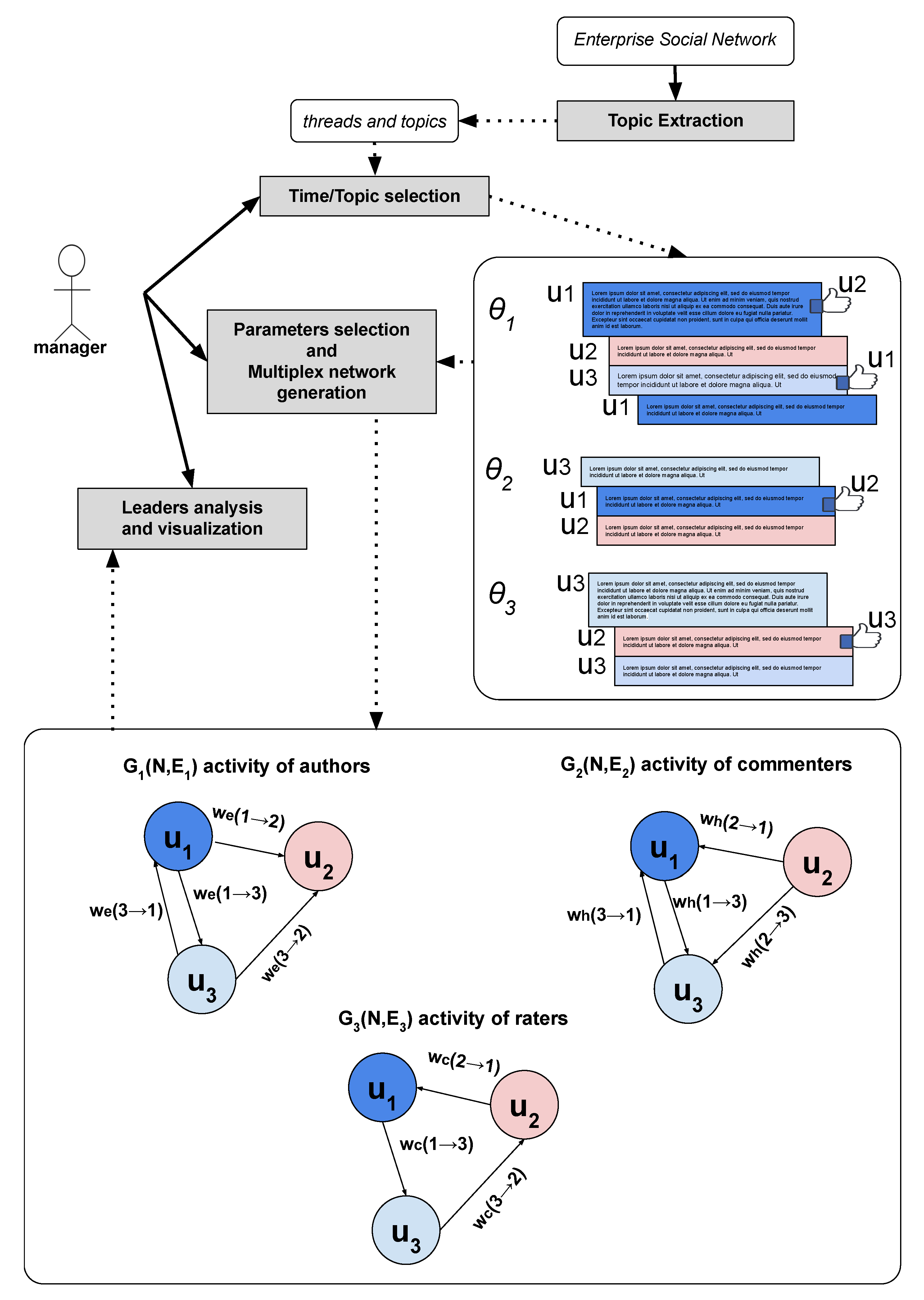

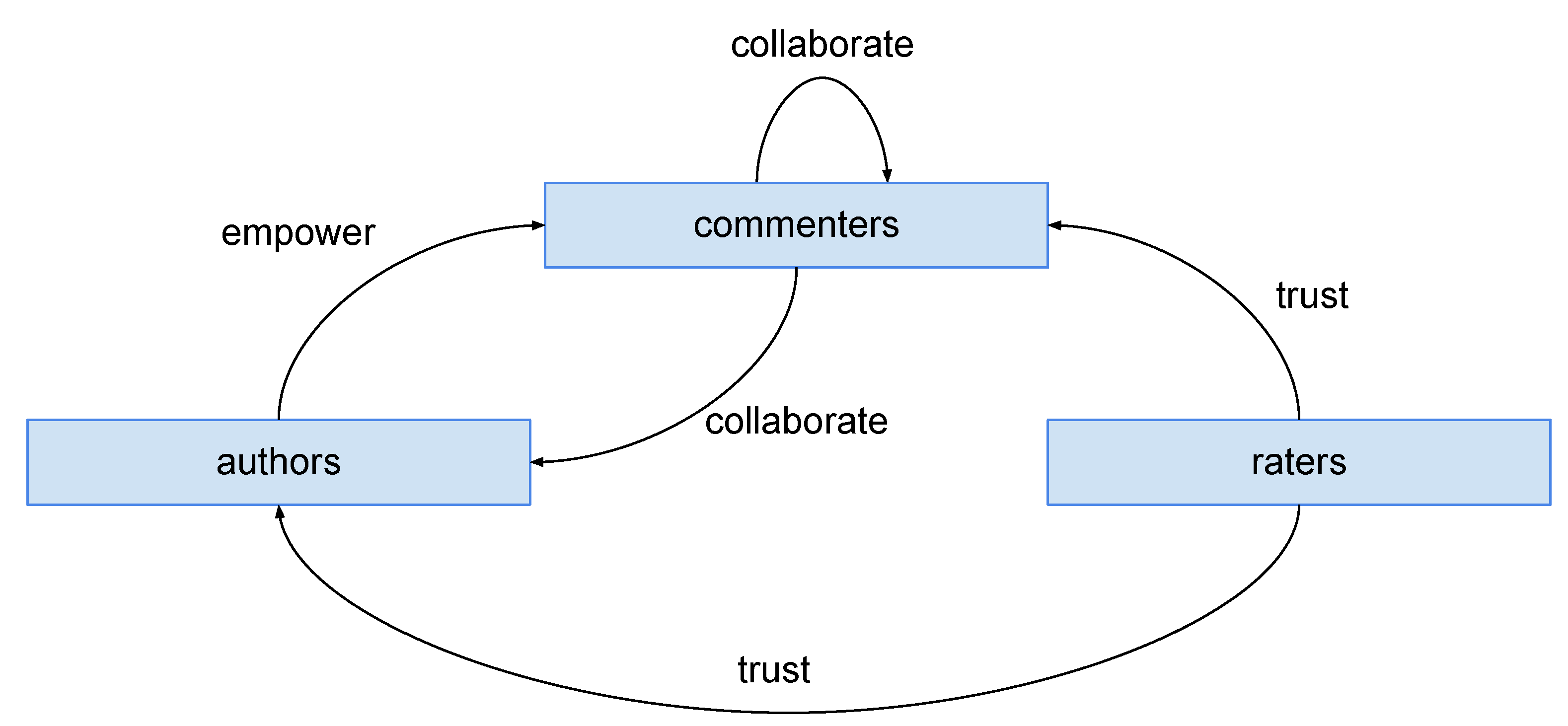

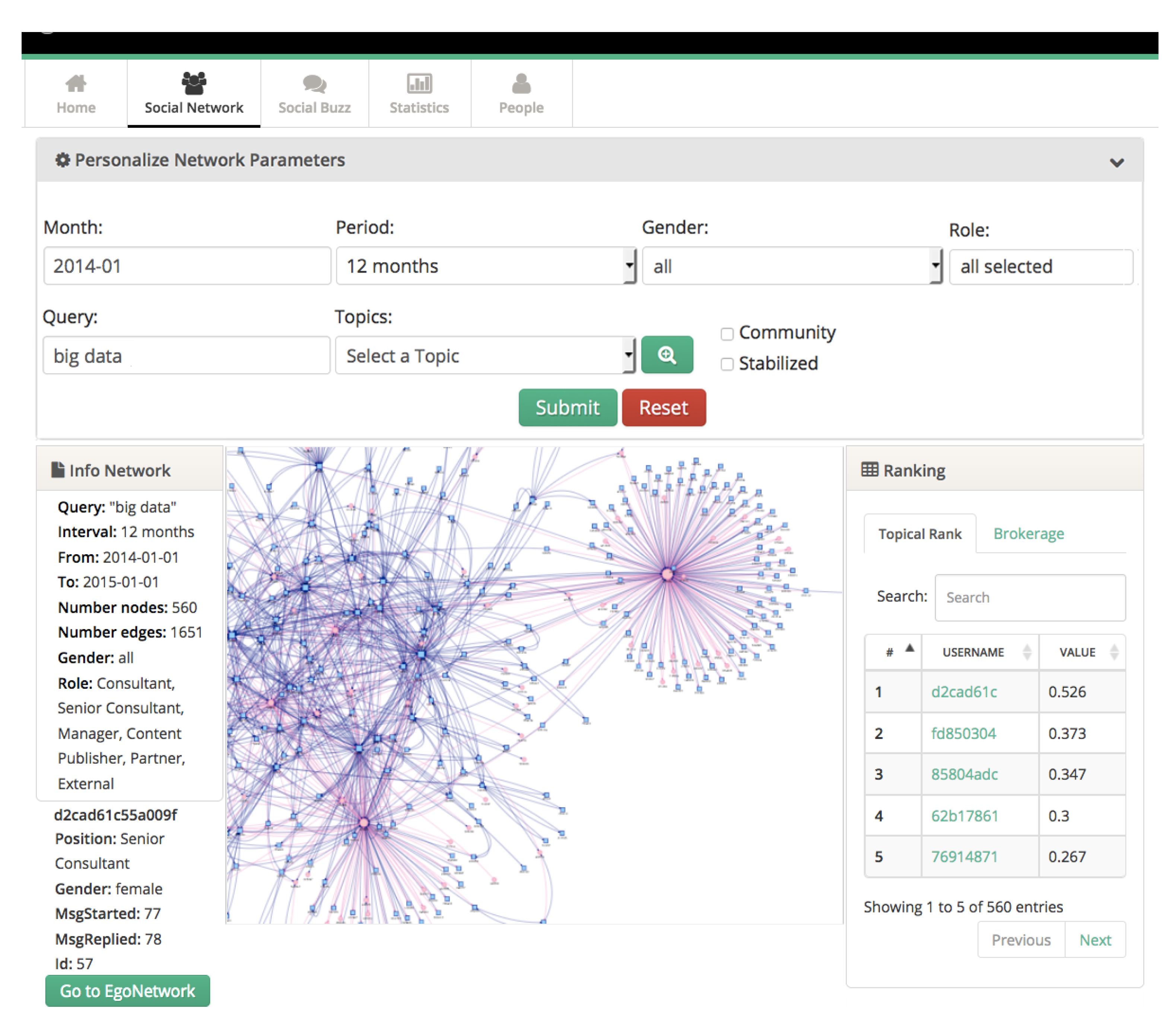
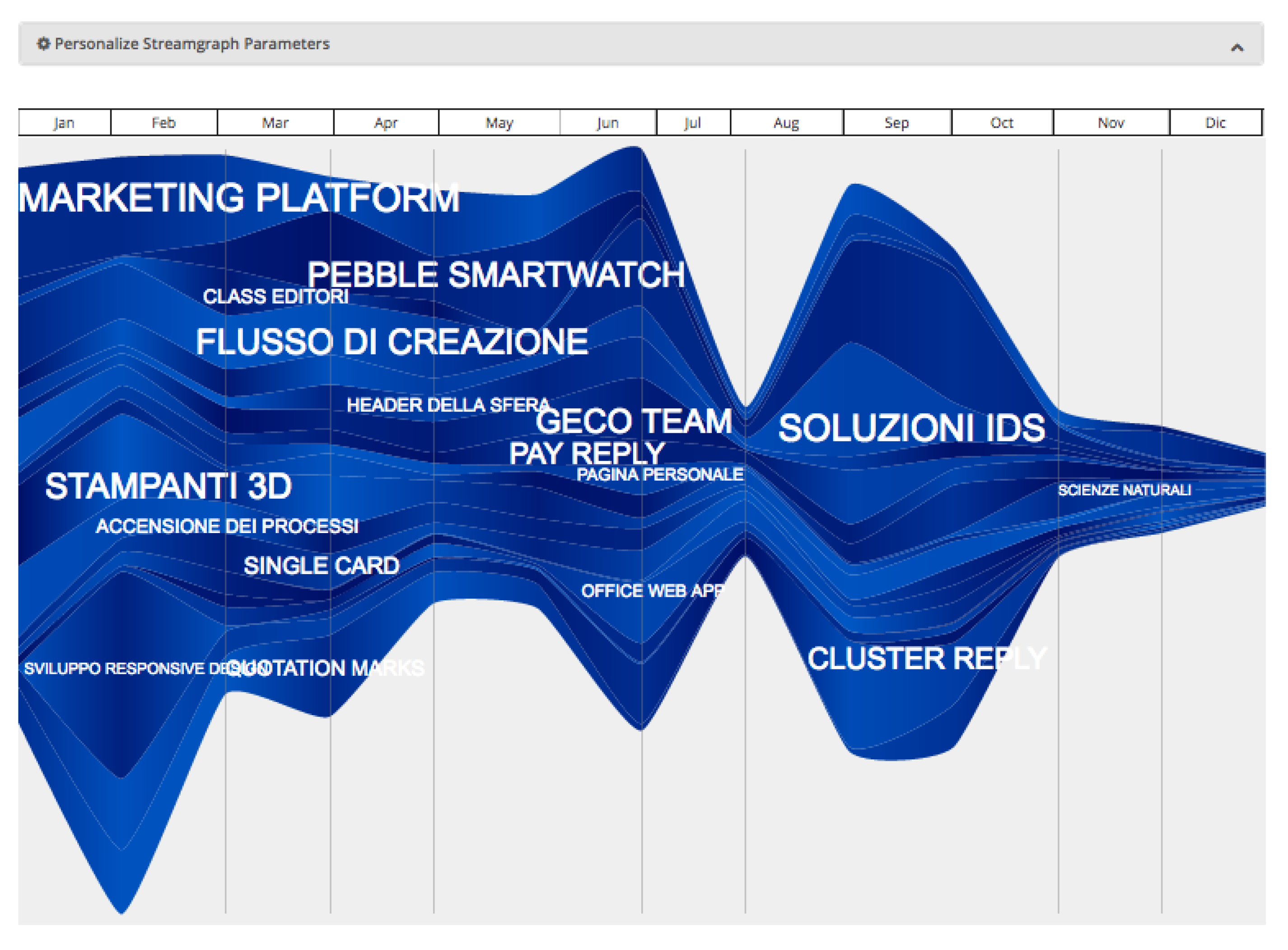
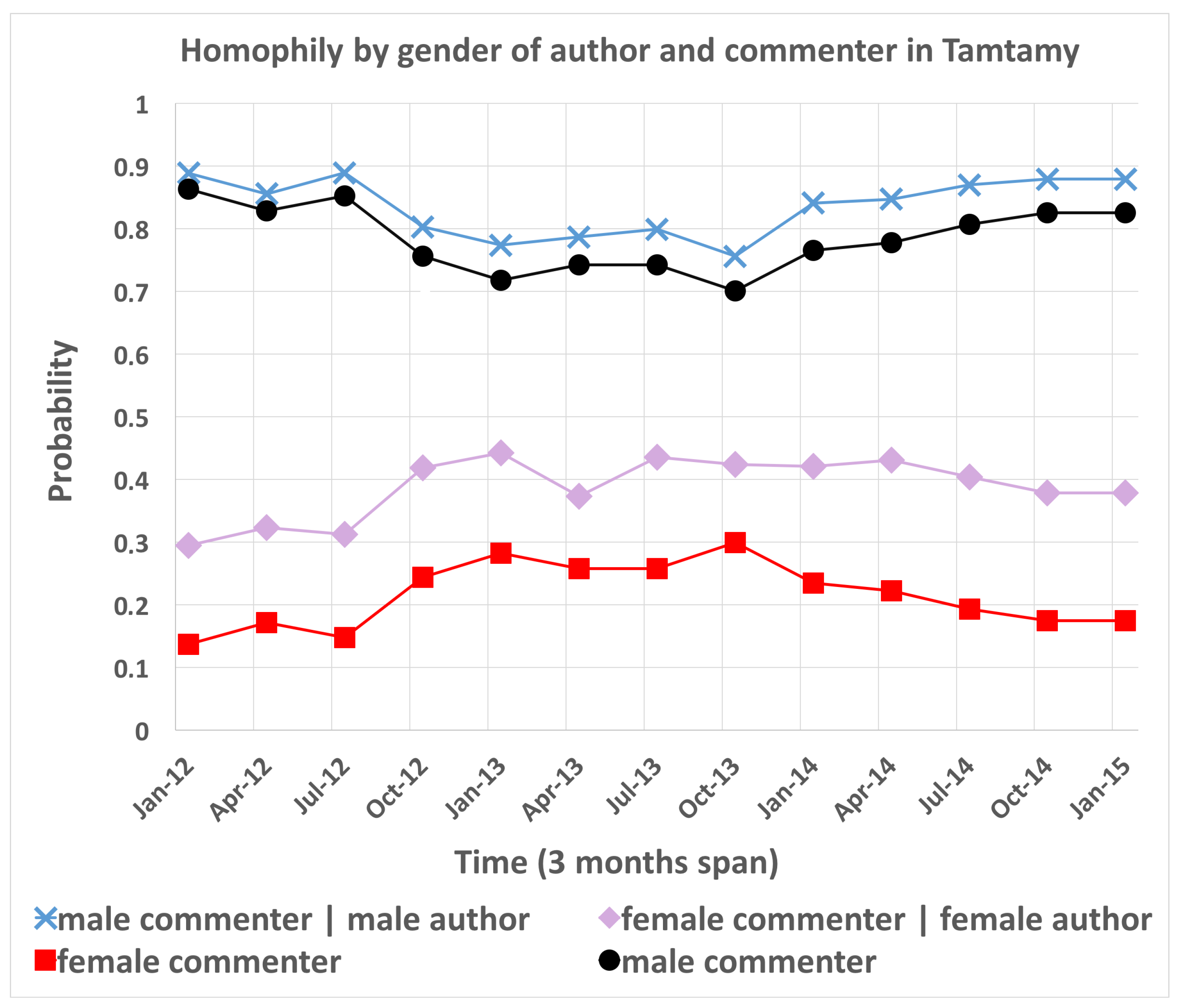
| Parameter | Description | Default or Tuned Value |
|---|---|---|
| , Equation (1), Section 5 | to control the weight of leadership centrality rank in the computation of the Network Leadership Rank | 0.5 |
| , Equation (1), Section 5 | to control the weight of brokerage rank in the computation of the Network Leadership Rank | 0.5 |
| , , Equation (3), Section 5.2 | to control the importance of comments | 0.5 |
| , , Equation (7), Section 5.2 | to control the importance of trust | 0.5 |
| , , Equations (7)–(9), Section 5.2 | teleporting factors for the trust, empowerment, and collaboration layers, respectively | 0.85 |
| , , Equations (8) and (9), Section 5.2 | to control the mutual influence between collaboration, empowerment, and trust layers | 1.0 |
| , Section 5.4 | threshold frequency of the elements in concept cliques | 3.0 |
| , Section 5.4 | threshold for the cosine-similarity score between context and category vectors | 0.8 |
| 2012 | 2013 | 2014 | |
|---|---|---|---|
| # active users (authors and/or commenters) | 932 | 1367 | 2085 |
| % active females users | 23% | 20% | 21% |
| # and % of active executives (managers or partners) | 264 (28.3%) | 346 (25.3%) | 435 (20%) |
| #threads (of which, with at least one comment) | 13,625 (4113) | 18,727 (4043) | 19,356 (4001) |
| % female-authored threads (with comments) | 15% | 24.5% | 25% |
| #comments | 20,272 | 17,187 | 16,560 |
| % female comments | 17.9% | 27.3% | 20% |
| % females in top LCR (centrality) | 23% | 23% | 7% (22% in 1st semester) |
| % females in top LBR (brokerage) | 26% | 27% | 32% |
| Technical | Leisure | Organ/Admin | |
|---|---|---|---|
| n. of classified threads | 2340 (54.9%) | 157 (3.7%) | 1767(41.4%) |
| n. of classified topics | 218 (55.5%) | 35 (8.9%) | 140 (20%) |
| % females in top topic LCR | 40.0% | 40.0% | 40.0% |
| % females in top thread LCR | 20.0% | 50.0% | 40.0% |
| % females in top topic LBR | 50.0% | 60.0% | 50.0% |
| % females in top thread LBR | 50.0% | 50.0% | 40.0% |
Publisher’s Note: MDPI stays neutral with regard to jurisdictional claims in published maps and institutional affiliations. |
© 2021 by the authors. Licensee MDPI, Basel, Switzerland. This article is an open access article distributed under the terms and conditions of the Creative Commons Attribution (CC BY) license (https://creativecommons.org/licenses/by/4.0/).
Share and Cite
Di Tommaso, G.; Faralli, S.; Gatti, M.; Iannotta, M.; Stilo, G.; Velardi, P. An Enterprise Social Analytics Dashboard to Support Competence Valorization and Diversity Management. Appl. Sci. 2021, 11, 8385. https://doi.org/10.3390/app11188385
Di Tommaso G, Faralli S, Gatti M, Iannotta M, Stilo G, Velardi P. An Enterprise Social Analytics Dashboard to Support Competence Valorization and Diversity Management. Applied Sciences. 2021; 11(18):8385. https://doi.org/10.3390/app11188385
Chicago/Turabian StyleDi Tommaso, Giorgia, Stefano Faralli, Mauro Gatti, Michela Iannotta, Giovanni Stilo, and Paola Velardi. 2021. "An Enterprise Social Analytics Dashboard to Support Competence Valorization and Diversity Management" Applied Sciences 11, no. 18: 8385. https://doi.org/10.3390/app11188385
APA StyleDi Tommaso, G., Faralli, S., Gatti, M., Iannotta, M., Stilo, G., & Velardi, P. (2021). An Enterprise Social Analytics Dashboard to Support Competence Valorization and Diversity Management. Applied Sciences, 11(18), 8385. https://doi.org/10.3390/app11188385







